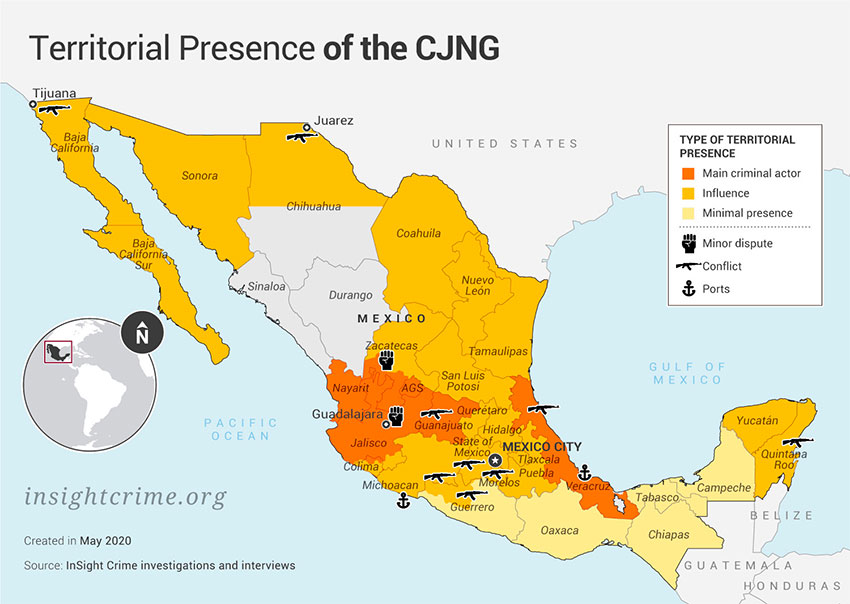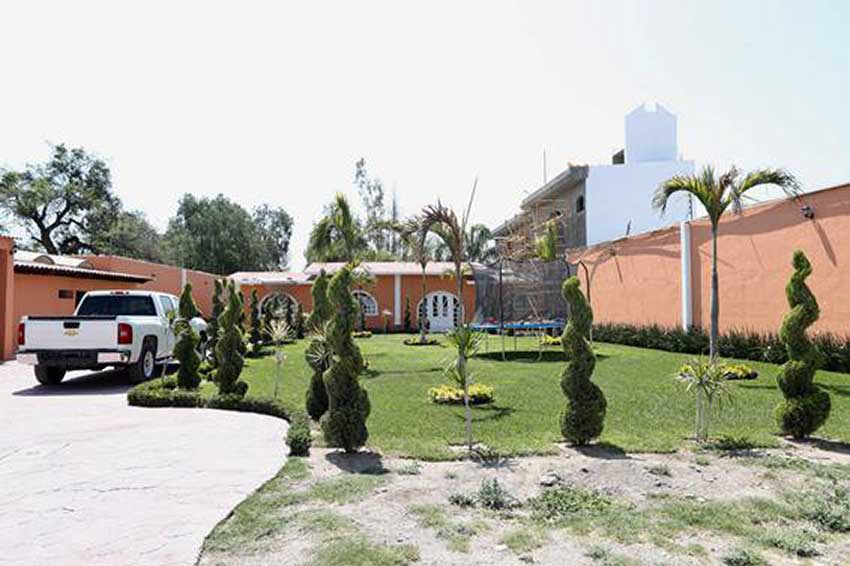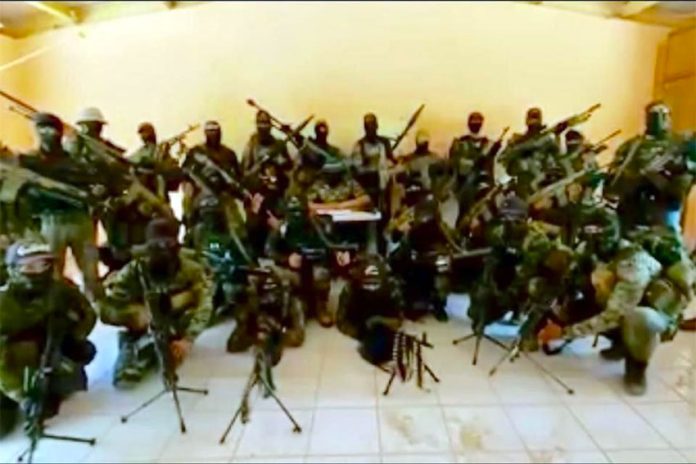Headlines and United States indictments have confidently proclaimed the Jalisco New Generation Cartel (CJNG) to be Mexico’s dominant criminal group. But while it is certainly one of the country’s principal national security threats, the reality on the ground is far more complex as the group is embroiled in a patchwork of rivalries nationwide.
The rise of the CJNG after its split from the Sinaloa Cartel in 2010 was rapid. As other groups splintered across Mexico, it maintained a hierarchical, disciplined structure that allowed it to gain territory and members. In January 2019, InSight Crime named the CJNG one of its “Criminal Winners” for 2018, based on its territorial presence, its income from cocaine and synthetic drug trafficking, its control of port infrastructure and its ability to launder money.
But presence does not equal dominance. There cannot be one single dominant criminal actor in a country as politically, economically and criminally diverse as Mexico. Like other large cartels, the CJNG has found it increasingly difficult to control strategic territories the more it has expanded.
Here, InSight Crime zeroes in on the main regions in which CJNG operates and the resistance they face:
Areas with major disputes
Northern Mexico
In the Golden Triangle — a crucial drug-producing region composed of the states of Sinaloa and Durango, as well as large parts of Chihuahua — the Sinaloa Cartel continues to be the major criminal player. The fall of Joaquín Guzmán Loera, alias “El Chapo,” has led to a potential rift between his successor, Ismael Zambada García, alias “El Mayo,” and Guzmán Loera’s sons, but the CJNG has not been able to turn the acrimony to its advantage.
Despite attempted shows of strength on the fringes of the Golden Triangle, this remains the part of Mexico where the CJNG lacks any real influence.
But along the border with the United States, the group has been involved in a series of violent clashes for control of border crossings.
In the city of Tijuana, the CJNG and Sinaloa Cartel are the main providers of synthetic drugs, especially fentanyl. In order to wrest control of the city from the Sinaloa Cartel, the CJNG allied itself with the weakened Tijuana Cartel, which rebranded itself as the Tijuana New Generation Cartel.
So far, this has not been entirely successful as the alliance has not weakened the Sinaloa Cartel’s considerable membership and intelligence network in the city, which is built on a tight relationship with local officials and institutions.

Another key crossing is Ciudad Juárez in Chihuahua, infamous for once being the most violent city in the world.
The CJNG has a presence in Ciudad Juárez, supposedly bolstered by an alliance with the New Juárez Cartel. But to date, it still appears to have less influence there than rivals such as Los Salazar, a powerful cell of the Sinaloa Cartel, and La Línea, an increasingly powerful faction of the Juárez Cartel. Furthermore, the city has numerous smaller street gangs, which control much of the micro-trafficking.
To the east, the border state of Tamaulipas has long been a prized criminal enclave. But again, the CJNG does not have much influence there. According to Óscar Balderas, a Mexican journalist and expert in organized crime, Tamaulipas is divided between the Northeast Cartel and the New Blood Zetas, as well as the remnants of the Gulf Cartel. In June 2020, reports emerged that the CJNG might be making further incursions into Tamaulipas through an alliance with Los Metros, a rising faction of the Gulf Cartel.
And while the CJNG appears to have made bolder attempts to take over northern cities such as Torreón and Monterrey, it has not established itself as the dominant criminal player in northern Mexico.
Tierra Caliente
The region of Tierra Caliente, covering parts of the states of Michoacán, Guerrero and the state of México, is home to arguably Mexico’s most complex criminal panorama. A report by the International Crisis Group found at least 20 distinct criminal groups there, vying for control of synthetic drug production, drug trafficking routes coming in via the Pacific and for the increasingly lucrative extortion of the avocado industry.
And while the CJNG is certainly the largest and the most well-funded group in Tierra Caliente, this has not been enough to overcome entrenched local groups with popular support.
Among the CJNG’s most consistent enemies in the area have been the Cartel del Abuelo and Los Viagras.
The Cartel del Abuelo operates from the municipality of Tepalcatepec, in western Michoacán. Its leader, Juan José Farías Álvarez, alias “El Abuelo,” began by leading a vigilante group, or “autodefensa,” against the Knights Templar.
According to some reports, Farías Álvarez even once allied himself with the CJNG as the large cartel moved into Michoacán. But in 2019, the CJNG began a series of bloody assaults against the Cartel del Abuelo, with CJNG boss Nemesio Oseguera Cervantes, alias “El Mencho,” even reportedly issuing a personal statement threatening Farías Álvarez.
These attacks have not been successful yet. In early May 2020, Farías Álvarez called on vigilante groups in four municipalities to unite and resist the “invasion” by the CJNG.
Los Viagras are a splinter group from both La Familia Michoana and the Knights Templar, devoted mainly to drug trafficking and extortion. This has brought the group into regular conflict with the CJNG since 2017 but with no side gaining a distinct advantage.

Both Los Viagras and the Cartel del Abuelo have profound strategic advantages over the CJNG, which include a deep knowledge of the land and loyalty among the local population.
“They are entrenched among local society,” Falko Ernst, senior analyst with International Crisis Group, told InSight Crime.
This means that crucial information needed to dominate a region — such as knowledge of escape routes, safe houses and warnings of operations by authorities — are not being shared with the CJNG.
“The communities are not interested in accepting the CJNG,” Ernst added.
And in Guerrero, the heartland of poppy growing for heroin production, splinter groups from larger crime organizations have become a nightmare for the CJNG. It is one of at least 40 groups vying for criminal economies there.
Mexico City and its surroundings
The center of Mexico City is largely controlled by La Unión Tepito, a gang native to the capital, though smaller groups such as the Cartel de Tláhuac enjoy plentiful incomes from extortion and micro-trafficking.
According to Balderas, the CJNG is present in the capital, especially in certain poorer neighborhoods to the north of the city, but it has not succeeded in becoming a main criminal actor as of yet.
Seeking a dominant position in Mexico City — where authorities are quicker to react than in many other parts of the country — may simply not be a priority for the CJNG.
“If the CJNG does happen to act with authority in Mexico City, authorities immediately crack down,” Balderas said.
And in states surrounding the capital, the CJNG is running into the results of criminal fragmentation.
Morelos and the state of México offer plenty of criminal economies, including human trafficking, kidnapping, micro-trafficking and drug trafficking, especially heroin. But these criminal economies are already bitterly contested by Los Rojos, dissidents from the Beltrán Leyva Organization, splinter groups from La Familia Michoacana and criminal gangs from Mexico City.

The Riviera Maya
In southeastern Mexico, the resorts of Cancún and Playa del Carmen are hotspots for human trafficking, money laundering, extortion and drug dealing. The port of Chetumal is a gateway for chemical precursors used in the production of synthetic drugs. And the Yucatán Peninsula is an increasingly popular zone for drug shipments moving in by land, sea and air.
The CJNG has made direct attempts to dominate this area but continues to face the Sinaloa Cartel, remnants of Los Zetas and Los Pelones, another group to emerge from the fragmentation of the Gulf Cartel.
These battles for territorial control have caused violence to flare up. Los Pelones, for example, are dedicated to extorting tourist businesses. In recent years, several shootings have occurred in bars or clubs, where rivals, including the CJNG, are trying to wrest control of this extortion racket.
Areas of control
There is no region where the CJNG can be said to enjoy total dominance but there are zones where it has consolidated its position as the most powerful criminal actor.
Jalisco
The CJNG dominates the western state of Jalisco, which gave the group its name.
Many of the group’s members live in and around the state capital, Guadalajara, and the city is also one of the CJNG’s main centers for money laundering. The U.S. Treasury Department has included on its blacklists various businesses connected to the cartel in the city.
The city of Puerto Vallarta, on the Pacific coast, has also been used by the CJNG for money laundering, human trafficking and drug trafficking. It was in this city that the CJNG kidnapped and briefly held two of El Chapo’s sons in August 2016.
“Puerto Vallarta is completely theirs,” Balderas said.
The power of the CJNG in Jalisco also extends to certain municipalities in neighboring states like Zacatecas and Aguascalientes, as well as the coasts of Nayarit, Colima and Michoacán. In Nayarit, the CJNG has also managed to create connections to senior officials, including a former state attorney general and governor.
However, its control has not gone uncontested. Since at least 2017, a CJNG splinter group, calling itself the Nueva Plaza Cartel, has engaged in regular battles with the larger cartel.
Guanajuato, Querétaro and Hidalgo
The Santa Rosa de Lima Cartel (CSRL) has arguably been the CJNG’s most notable rival in the last two years, despite being confined to a limited area in central Mexico. This group reportedly arose in 2017 when several gangs dedicated to oil theft banded together to stop the CJNG’s incursions into Guanajuato, Querétaro and Hidalgo.
According to Víctor Sánchez, a national security expert at the University of Coahuila, the CSRL was initially able to stave off CJNG advances due to its strong backing from local communities that profit from oil theft.
But the CSRL has been severely weakened by repeated government assaults, and the CJNG has managed to seize control of criminal economies in these three states, although not without spilling blood. According to Balderas, pockets of resistance to the CJNG still remain in certain municipalities of Guanajuato, such as Villagrán, but these are not believed to be highly strategic for organized crime groups.
“The most recent outbreaks of violence have been the execution of the last soldiers [of the CSRL],” Balderas said.
This is a war the CJNG looks to have won.
Veracruz
Mexico’s Atlantic coast was traditionally contested between the Gulf Cartel and the Zetas. When these groups weakened and fractured, it took years for another criminal organization to assert control over this strategic zone.
Today, the CJNG appears to have done so but at a terrible cost. Its battles against a Zetas splinter group, known as the Old School Zetas, have ended in massacres. The most notorious example came in April 2019 when 14 people were murdered during a party in the town of Minatitlán.
“Veracruz was always going to be the jewel in the crown for the CJNG,” Balderas said. The state is important for its ports and access to trans-Atlantic drug routes, as well as being a corridor for human trafficking. Now, the Old School Zetas have a presence in only certain municipalities such as Coatzacoalcos and Minatitlán, but Veracruz’s strategic points are held by the CJNG.
“A large part of Veracruz is now controlled by the CJNG,” Balderas said. “The Zetas have been decimated.”
Reprinted from InSight Crime. The author is an investigator with InSight Crime, a foundation dedicated to the study of organized crime.
